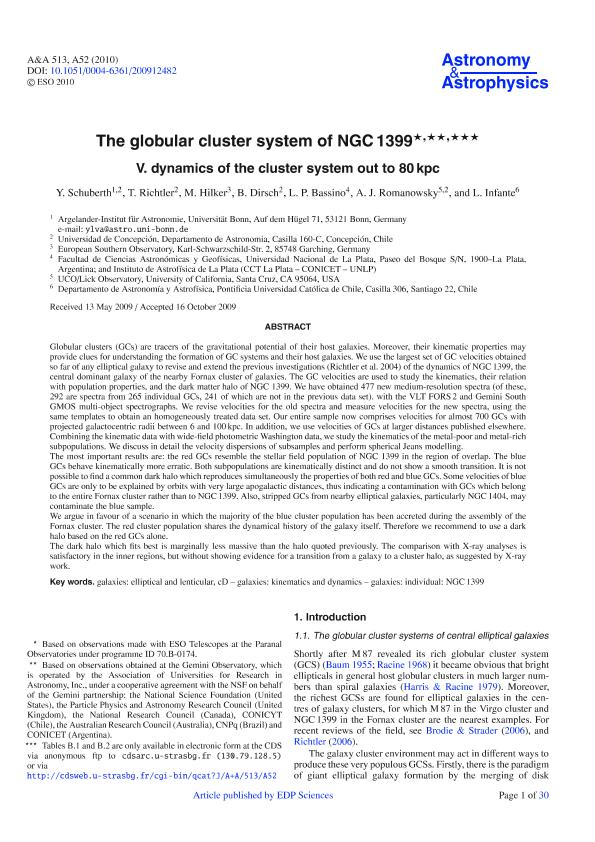Mostrar el registro sencillo del ítem
dc.contributor.author
Shuberth, Y.
dc.contributor.author
Richtler, T.
dc.contributor.author
Hilker, M.
dc.contributor.author
Dirsch, B.
dc.contributor.author
Bassino, Lilia Patricia

dc.contributor.author
Romanowsky, A. J.
dc.contributor.author
Infante, L.
dc.date.available
2016-12-22T19:13:22Z
dc.date.issued
2010-04
dc.identifier.citation
Shuberth, Y.; Richtler, T.; Hilker, M.; Dirsch, B.; Bassino, Lilia Patricia; et al.; The globular cluster system of NGC 1399: V. dynamics of the cluster system out to 80 kpc; Edp Sciences; Astronomy And Astrophysics; 513; 4-2010; 1-30
dc.identifier.issn
0004-6361
dc.identifier.uri
http://hdl.handle.net/11336/9959
dc.description.abstract
Globular clusters (GCs) are tracers of the gravitational potential of their host galaxies. Moreover, their kinematic properties may provide clues for understanding the formation of GC systems and their host galaxies. We use the largest set of GC velocities obtained so far of any elliptical galaxy to revise and extend the previous investigations (Richtler et al. 2004) of the dynamics of NGC 1399, the central dominant galaxy of the nearby Fornax cluster of galaxies. The GC velocities are used to study the kinematics, their relation with population properties, and the dark matter halo of NGC 1399. We have obtained 477 new medium-resolution spectra (of these, 292 are spectra from 265 individual GCs, 241 of which are not in the previous data set). with the VLT FORS 2 and Gemini South GMOS multi-object spectrographs. We revise velocities for the old spectra and measure velocities for the new spectra, using the same templates to obtain an homogeneously treated data set. Our entire sample now comprises velocities for almost 700 GCs with projected galactocentric radii between 6 and 100 kpc. In addition, we use velocities of GCs at larger distances published elsewhere. Combining the kinematic data with wide-field photometric Washington data, we study the kinematics of the metal-poor and metal-rich subpopulations. We discuss in detail the velocity dispersions of subsamples and perform spherical Jeans modelling.
The most important results are: the red GCs resemble the stellar field population of NGC 1399 in the region of overlap. The blue GCs behave kinematically more erratic. Both subpopulations are kinematically distinct and do not show a smooth transition. It is not possible to find a common dark halo which reproduces simultaneously the properties of both red and blue GCs. Some velocities of blue GCs are only to be explained by orbits with very large apogalactic distances, thus indicating a contamination with GCs which belong to the entire Fornax cluster rather than to NGC 1399. Also, stripped GCs from nearby elliptical galaxies, particularly NGC 1404, may contaminate the blue sample.
We argue in favour of a scenario in which the majority of the blue cluster population has been accreted during the assembly of the Fornax cluster. The red cluster population shares the dynamical history of the galaxy itself. Therefore we recommend to use a dark halo based on the red GCs alone.
The dark halo which fits best is marginally less massive than the halo quoted previously. The comparison with X-ray analyses is satisfactory in the inner regions, but without showing evidence for a transition from a galaxy to a cluster halo, as suggested by X-ray work.
dc.format
application/pdf
dc.language.iso
eng
dc.publisher
Edp Sciences

dc.rights
info:eu-repo/semantics/openAccess
dc.rights.uri
https://creativecommons.org/licenses/by-nc-sa/2.5/ar/
dc.subject
Galaxies
dc.subject
Elliptical Galaxies
dc.subject
Kinematics (Galaxias)
dc.subject
Ngc 1399 (Galaxia)
dc.subject.classification
Astronomía

dc.subject.classification
Ciencias Físicas

dc.subject.classification
CIENCIAS NATURALES Y EXACTAS

dc.title
The globular cluster system of NGC 1399: V. dynamics of the cluster system out to 80 kpc
dc.type
info:eu-repo/semantics/article
dc.type
info:ar-repo/semantics/artículo
dc.type
info:eu-repo/semantics/publishedVersion
dc.date.updated
2016-12-14T12:56:09Z
dc.journal.volume
513
dc.journal.pagination
1-30
dc.journal.pais
Francia

dc.journal.ciudad
Les Ulis
dc.description.fil
Fil: Shuberth, Y.. Universitaet Bonn; Alemania. Universidad de Concepción; Chile
dc.description.fil
Fil: Richtler, T.. Universidad de Concepción; Chile
dc.description.fil
Fil: Hilker, M.. European Southern Observatory; Alemania
dc.description.fil
Fil: Dirsch, B.. Universidad de Concepción; Chile
dc.description.fil
Fil: Bassino, Lilia Patricia. Universidad Nacional de la Plata. Facultad de Ciencias Astronómicas y Geofísicas; Argentina. Consejo Nacional de Investigaciones Científicas y Técnicas. Centro Científico Tecnológico La Plata. Instituto de Astrofísica de La Plata; Argentina
dc.description.fil
Fil: Romanowsky, A. J.. California State University; Estados Unidos
dc.description.fil
Fil: Infante, L.. Universidad Católica de Chile; Chile
dc.journal.title
Astronomy And Astrophysics

dc.relation.alternativeid
info:eu-repo/semantics/altIdentifier/doi/http://dx.doi.org/10.1051/0004-6361/200912482
dc.relation.alternativeid
info:eu-repo/semantics/altIdentifier/url/http://www.aanda.org/articles/aa/abs/2010/05/aa12482-09/aa12482-09.html
Archivos asociados
